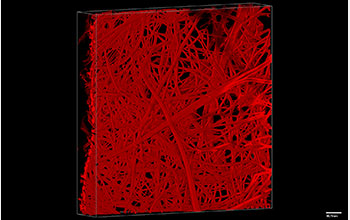Multimedia Gallery
Cotton candy machines may hold key for making artificial organs (Image 1)
A microphotograph of microfibers that serve as a template to form a microvascular network.
More about this image
Leon Bellan, a mechanical engineer at Vanderbilt University, is working to create artificial human capillary blood vessels using cotton candy and gelatin. His goal is for researchers to use these man-made capillaries to help keep artificial organs and other tissues alive, which could dramatically impact the field of regenerative medicine.
Bellan’s lab is hoping these artificial capillaries will be a part of what he calls a "vascular toolbox" to help researchers sustain multiple types of human tissue. "If you want to build thick tissue you need this vascular network, this sort of internal plumbing to help keep the cells embedded within alive," said Bellan. "This vascularization issue is a hurdle for lots of areas of tissue engineering, so we feel our research can have far-reaching benefits."
Bellan’s lab focuses on the smallest blood vessels in the human body, the capillaries. His unique "cotton candy" technique allows them to build channels that match this size.
"Our lab basically makes unique materials based on this sacrificial cotton candy approach that we’ve developed where we embed cotton candy or cotton candy-like materials within gelatin and then remove the fibers to make an intricate 3-D channel system," said Bellan. When the gelatin is poured over the cotton candy, the materials do not blend together because Bellan figured out a way to dissolve the cotton candy on command.
"When the jello has set, we change the PH and then the fibers dissolve," said Bellan.
Bellan’s lab grows endothelial cells with the goal of implanting them into the artificial channels. But, like real capillaries, the artificial blood vessels are miniscule, about 1/10 the size of a human hair. This makes the next step of lining the artificial channels with real human cells extremely challenging.
"We’re essentially trying to fit a 10 micron suspended cell within a 10 micron channel," said Bellan. "What we’re trying to work out right now is how to get the cells into the channels without clogging."
The next step in the research is to see if Bellan’s artificial capillaries will be accepted by real tissue.
[Research funded by National Science Foundation grant DMR 15-06717.]
To learn more, see the YouTube video Cotton candy and artificial blood vessels. (Date image taken: 2015-2016; date originally posted to NSF Multimedia Gallery: July 12, 2016) [Image 1 of 3 related images. See Image 2.]
Credit: Vanderbilt University
Images and other media in the National Science Foundation Multimedia Gallery are available for use in print and electronic material by NSF employees, members of the media, university staff, teachers and the general public. All media in the gallery are intended for personal, educational and nonprofit/non-commercial use only.
Images credited to the National Science Foundation, a federal agency, are in the public domain. The images were created by employees of the United States Government as part of their official duties or prepared by contractors as "works for hire" for NSF. You may freely use NSF-credited images and, at your discretion, credit NSF with a "Courtesy: National Science Foundation" notation.
Additional information about general usage can be found in Conditions.
Also Available:
Download the high-resolution JPG version of the image. (1019.1 KB)
Use your mouse to right-click (Mac users may need to Ctrl-click) the link above and choose the option that will save the file or target to your computer.



